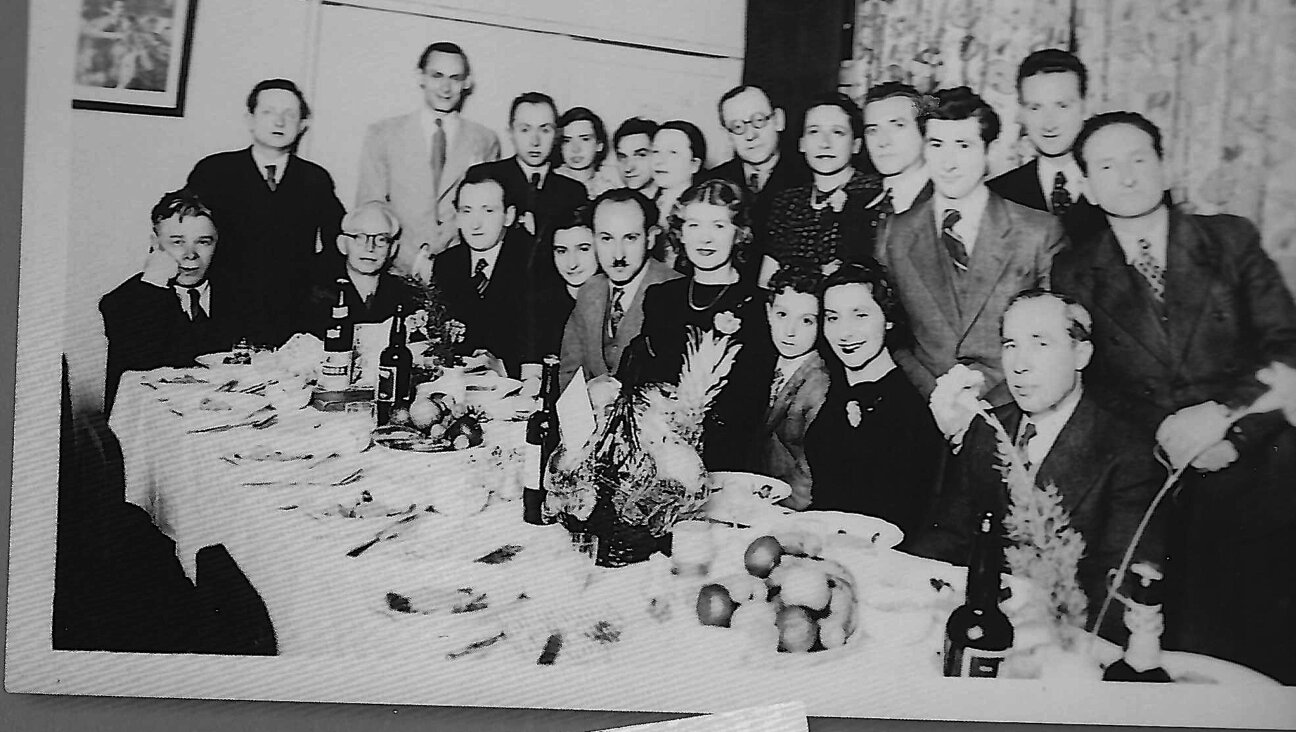When In Rome

Image by COURTESY LEAH KOENIG
Inside the kosher bakery, a corner storefront no larger than a college dorm room, a jumble of customers jostles for service. It’s Friday afternoon, so the shop’s front window is stacked with loaves of fresh challah. Two display cases hold an array of tantalizing sweets: molten-centered macaroons, cocoa biscotti, and wedges of sweet cheese and sour cherry tart, which three shopkeepers slip into bags and release into the eager sea of outstretched hands.
The bakery’s swirl of sugar and good-natured chaos could easily be found in the depths of Brooklyn or down a Jerusalem side street. But this bakery, the 200-year-old Pasticceria il Boccione, is on Via Del Portico d’Ottavia — the main drag in Rome’s Jewish ghetto neighborhood. And it is not alone.
Two doors down, a casual eatery called BeteAvon presses panini with mozzarella and zucchini concia, an ancient Roman Jewish preparation that marinates vegetables to the edge of disintegration in garlic, olive oil and herbs. Across the piazza, Kosher Bistrot Caffe doubles as a spot for sipping espresso, as well as a kosher grocery store stocked with vinegar and Parmigiano-Reggiano. And down the block, La Taverna del Ghetto serves deep-fried zucchini blossoms and sweetbreads, salt cod simmered in tomato sauce and Rome’s most famous Jewish side dish: carciofi alla giudia, salt-kissed fried artichokes.
Every day except for Saturday, when most of the shops close for Shabbat, Via Del Portico d’Ottavia is a bustling main street. But the vibrancy found along the stone streets was not always there.
Rome’s Jewish community — Europe’s oldest — dates to the second century B.C.E. By the early 16th century, the city’s ancient Jews, called Italkim, were joined by Sephardim fleeing the Inquisition in Italy’s Spain-ruled south. They unfortunately did not find the solace they sought; shortly after their arrival, Pope Paul IV established a cramped, walled-in ghetto where, for the next 315 years, all Jews were forced to live.
In comparison, the latter half of the 20th century was kind to Rome’s Jews. But as recently as 30 years ago, the community was on the verge of fading away. The ghetto had long since been torn down, and the Tempio Maggiore (Great Synagogue), built in 1901, stood as a majestic marker of the city’s Jewish presence.
Outside of the ghetto’s confinement, however, Jewish residents dispersed across the city and assimilated heavily into secular Roman life.
“The younger generation was all getting intermarried and participation in Jewish life dwindled,” said Roy Doliner, who co-founded the cultural association, Rome for Jews. A handful of restaurants in the ghetto continued to serve the amalgam of Italkim and Sephardic dishes that define Rome’s traditional Jewish cuisine. But even these restaurants are mostly owned by non-Jews and are geared toward tourists, not the community.
Unlike many other vanishing European Jewish populations, however, Rome has experienced a significant upswing during the last few decades. One could argue that today, Rome’s Jewish population is as vibrant as it has been in centuries — if not more so. And according to Doliner, the change can largely be attributed to two “Ls:” Lubavitch and Libyans.
The arrival of Lubavitch Jews can be controversial for a city not accustomed to Ashkenazi culture or interested in higher standards of religiosity. But while not all of Rome’s Jews care for their Lubavitch neighbors, their influence has been largely positive. In addition to providing such services to the area as mashgichim (kosher supervisors), Lubavitch presence has put a healthy pressure on Roman Jews to reclaim and revitalize their own customs. And in the early 1970s, in the aftermath of Israel’s Six-Day War, several thousand Libyan Jews emigrated to Rome. In addition to boosting the overall Jewish population (now close to 16,000), the Libyans’ reverence for tradition has helped spark a larger revival of Jewish activity.
The majority of Rome’s Jews remain secular, but some are beginning to adopt observances that indicate a growing interest in their heritage — celebrating holidays, wearing yarmulkes, and sending their children to the Jewish day school, which accommodates nearly 800 students in a converted building in the heart of the ghetto.
While only 400 Jews still live in the ghetto neighborhood, it remains a vital community hub.
Micaela Pavoncello, a Roman Jew who founded the company Jewish Roma Walking Tours, describes the ghetto as an “open-air JCC,” where elders chat and students congregate at lunch. Similarly, Doliner said, “If there is an engagement or a family illness, the news cycles through the bakery,” referring to Pasticceria il Boccione.
Above all, the return of traditional food — arguably the lifeblood of all Italian culture — to the ghetto stands as an important indication of community health. In the last five years, a series of new restaurants has opened, like the Roman-Libyan fusion restaurant, Ba’’Ghetto, where diners can order their grilled lamb with either pasta or couscous, and end their meal the Libyan way: with a glass of sweetened mint tea steeped with peanuts. The dairy restaurant Nonna Betta serves the ancient flan-like Roman dessert cassola. And nearby, Yotvata’s wine list includes a handful of new kosher wines produced in Italy.
Jewish families opened most of these restaurants, and virtually all of them are kosher — catering to tourists as well as signaling the growing interest in kashrut amongst Rome’s Jews.
Food scholar Claudia Roden once wrote: “Every cuisine tells a story… Jewish cooking tells the history of a people and its vanished worlds.” While Roden’s point is well taken, it does not represent the situation in Rome. The classic Jewish dishes found in the ghetto, whether Italkim, Sephardic or Libyan, tell the story of a community that is ever in flux but decidedly strong.
As Pavoncello said, “Despite the hardships, we are not wandering Jews — we are proud to call Rome our home.”
It is this steadfastness, coupled with a growing pride in tradition, that has served the Jews of Rome well throughout its storied past, and, with any luck, for centuries to come.
Leah Koenig writes a monthly column on food and culinary trends. She can be contacted at [email protected].
Where To Eat
Ba’’ Ghetto
Roman, Libyan/Mediterranean (Meat)
Via Del Portico D’Ottavia 57
www.kosherinrome.com
BeteAvon
Casual Roman (Dairy)
Via Del Portico D’Ottavia 1/b
Kosher Bistrot Caffe
Coffee, Kosher Grocery
Via S. Maria Del Pianto 68/69
La Taverna del Ghetto
Roman (Meat)
Via Del Portico D’Ottavia 7/b-8
www.latavernadelghetto.com
Nonna Betta
Roman (Dairy)
Via del Portico d’Ottavia, 16
www.nonnabetta.it
Pasticceria il Boccione
Pastries and Sweets
Via Del Portico D’Ottavia 1/a
Yotvata
Roman (Dairy)
Piazza Cenci, 70
www.yotvata.it

I hope you appreciated this article. Before you go, I’d like to ask you to please support the Forward’s award-winning journalism this Passover.
In this age of misinformation, our work is needed like never before. We report on the news that matters most to American Jews, driven by truth, not ideology.
At a time when newsrooms are closing or cutting back, the Forward has removed its paywall. That means for the first time in our 126-year history, Forward journalism is free to everyone, everywhere. With an ongoing war, rising antisemitism, and a flood of disinformation that may affect the upcoming election, we believe that free and open access to Jewish journalism is imperative.
Readers like you make it all possible. Right now, we’re in the middle of our Passover Pledge Drive and we need 500 people to step up and make a gift to sustain our trustworthy, independent journalism.
Make a gift of any size and become a Forward member today. You’ll support our mission to tell the American Jewish story fully and fairly.
— Rachel Fishman Feddersen, Publisher and CEO
Join our mission to tell the Jewish story fully and fairly.
Our Goal: 500 gifts during our Passover Pledge Drive!
























